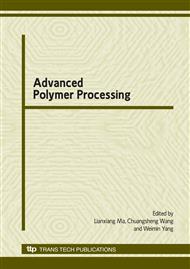p.125
p.130
p.134
p.137
p.143
p.149
p.154
p.160
p.167
Water-Activated Bacterial Cellulose-Based Electrorheological Fluids and Electromechanical Response of Artificial Muscle Based on Electrorheological Fluids and Siloxane Gel
Abstract:
Electrorheological (ER) characteristics of ER fluids (ERF) containing bacterial cellulose (BC) particles in silicone oil was investigated as a function of particle water content, DC electric field strength and particle concentration. It was found that the existence of water in BC particles strongly influenced the performance of water-activated ERF based on BC particles. Around 8.8 wt% water, yield stress reached its maximum valve of 1118 Pa after which it decreased with increasing water content. At the same water content, yield stress increased linearly with increasing in either electric field strength or particle concentration. The ERF based on BC particles was introduced into the poly (dimethylsiloxane) (PDMS) gels to prepare electric field sensitive composite gel. Electric fields were applied to these composite gels using flexible electrodes. Compressions of these gels with varying PDMS/ERF ratios were confirmed by the electrode displacement. It was found that 50/50 PDMS/ERF gel exhibited the maximum displacement of 102um at 2 kV/mm electric field.
Info:
Periodical:
Pages:
143-148
Citation:
Online since:
December 2009
Authors:
Price:
Сopyright:
© 2010 Trans Tech Publications Ltd. All Rights Reserved
Share:
Citation:


